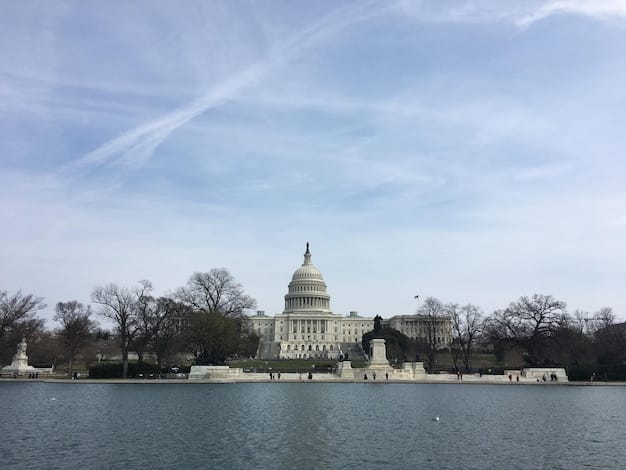The Impact of US Policy on Climate Change Initiatives

US policy significantly shapes climate change and environmental sustainability through regulations, investments, and international agreements, impacting global efforts to mitigate environmental issues.
The United States, as a global leader, plays a crucial role in addressing climate change and promoting environmental sustainability. Understanding the impact of US policy on climate change and environmental sustainability initiatives is essential for assessing global progress and future directions.
Understanding the Landscape of US Climate Policy
US climate policy is a complex and evolving field, shaped by a variety of factors including scientific understanding, economic considerations, and political ideologies. Examining the current landscape reveals the diverse approaches and challenges inherent in addressing climate change at the national level.
Key Federal Regulations
Federal regulations form a cornerstone of US climate policy, setting standards and guidelines for industries and activities that impact the environment.
- Clean Air Act: Regulates emissions from stationary and mobile sources.
- Clean Water Act: Protects and restores the nation’s waters.
- Endangered Species Act: Conserves threatened and endangered species and their habitats.
These regulations, while essential, often face challenges in implementation and enforcement due to political opposition and resource constraints.

The Role of Renewable Energy Incentives
Incentivizing the development and adoption of renewable energy is a critical component of US climate policy. Tax credits, grants, and loan programs aim to make renewable energy sources more competitive and accessible.
Tax Credits for Renewable Energy
Tax credits play a significant role in encouraging investment in renewable energy technologies.
- Production Tax Credit (PTC): Incentivizes electricity production from renewable sources.
- Investment Tax Credit (ITC): Supports investment in solar energy projects.
- Residential Renewable Energy Tax Credit: Encourages homeowners to install solar panels and other renewable energy systems.
These incentives stimulate growth in the renewable energy sector but require sustained political support to remain effective.
The impact of renewable energy incentives extends beyond just reducing carbon emissions; they also foster job creation, technological innovation, and energy independence.
US Participation in International Climate Agreements
International cooperation is essential for addressing climate change effectively. The United States’ engagement in global climate agreements reflects its commitment to tackling this global challenge.
The Paris Agreement and US Re-entry
The Paris Agreement is a landmark international accord aimed at limiting global warming to well below 2 degrees Celsius above pre-industrial levels.
- US Commitment: Nationally Determined Contributions (NDCs) outline emission reduction targets.
- Global Collaboration: Working with other nations to achieve collective climate goals.
- Adaptation Measures: Supporting vulnerable countries in adapting to climate impacts.
The United States’ re-entry into the Paris Agreement signals a renewed commitment to international climate action, but challenges remain in achieving the ambitious targets set forth.

Environmental Sustainability Initiatives at the State and Local Levels
While federal policies set the overarching framework, state and local governments play a crucial role in implementing environmental sustainability initiatives on the ground. These initiatives often demonstrate innovation and community engagement.
State Renewable Portfolio Standards (RPS)
Many states have adopted Renewable Portfolio Standards (RPS), which mandate a certain percentage of electricity to come from renewable sources.
- California’s RPS: One of the most ambitious in the nation, targeting 100% clean energy by 2045.
- New York’s Clean Energy Standard: Sets goals for renewable energy and energy efficiency.
- Massachusetts’ RPS: Requires a certain percentage of electricity to come from renewable sources.
These standards drive investment in renewable energy and contribute to emissions reductions at the state level.
State and local initiatives often reflect the unique environmental challenges and priorities of their communities, fostering resilience and sustainability.
The Economic Implications of Climate Policy
Climate policy has significant economic implications, both in terms of costs and benefits. Understanding these economic factors is essential for designing effective and sustainable policies.
Investing in Green Technologies
Investing in green technologies can create new jobs and stimulate economic growth.
- Renewable Energy Jobs: Solar, wind, and other renewable energy sectors are creating jobs across the country.
- Energy Efficiency: Improving energy efficiency in buildings and industries can reduce energy costs and emissions.
- Sustainable Transportation: Investing in electric vehicles and public transportation can reduce emissions and improve air quality.
The transition to a low-carbon economy requires strategic investments and policies to ensure a just and equitable transition for workers and communities.
Climate policy can drive innovation, create new markets, and enhance economic competitiveness in the long run.
Challenges and Future Directions
Despite progress in addressing climate change, significant challenges remain. Overcoming these challenges requires a concerted effort from policymakers, businesses, and individuals.
Political Polarization
Political polarization on climate change hinders the implementation of effective policies.
- Partisan Divide: Deep divisions between political parties on the severity and urgency of climate change.
- Lobbying Influence: Special interests can exert undue influence on policymaking.
- Regulatory Rollbacks: Changes in administration can lead to reversals of climate policies.
Building consensus and promoting bipartisan cooperation are essential for advancing climate action.
Future directions in US climate policy will likely involve a combination of regulatory measures, economic incentives, and technological innovations.
| Key Point | Brief Description |
|---|---|
| 📜 Federal Regulations | Rules like the Clean Air Act that set environmental standards. |
| 💰 Renewable Incentives | Tax credits for solar and wind to boost green energy. |
| 🌍 International Agreements | Commitments like the Paris Agreement for global climate action. |
| 🏢 State Initiatives | Local efforts to promote renewable energy and sustainability. |
Frequently Asked Questions
▼
Key regulations include the Clean Air Act, which limits emissions, and the Clean Water Act, aimed at protecting the nation’s waters from pollution.
▼
Tax credits, like the Investment Tax Credit (ITC) for solar, reduce the costs for businesses and individuals, encouraging investments in renewable energy.
▼
The US has committed to reducing its greenhouse gas emissions by a certain percentage below 2005 levels by 2030, as part of its NDCs.
▼
RPS are state-level policies mandating that a certain amount of electricity must come from renewable sources, like solar or wind, promoting clean energy.
▼
Bipartisan cooperation ensures that climate policies are sustainable and can withstand political changes, leading to long-term, effective solutions.
Conclusion
In conclusion, US policy plays a pivotal role in shaping climate change and environmental sustainability initiatives. From federal regulations and renewable energy incentives to international agreements and state-level programs, a multi-faceted approach is essential for addressing this global challenge effectively. Overcoming political polarization and fostering bipartisan cooperation will be crucial for advancing climate action and building a sustainable future.





